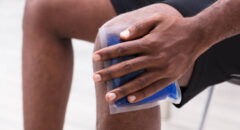 Think you're too young to worry about arthritis? Think again...half of those who get it are under age 65, but it's only diagnosed later after years of ignoring early, and surprising, warning signs - aside from pain, which is only one of the most common symptoms.
Think you're too young to worry about arthritis? Think again...half of those who get it are under age 65, but it's only diagnosed later after years of ignoring early, and surprising, warning signs - aside from pain, which is only one of the most common symptoms.
Read: Rheumatoid Arthritis: An Overview
"Early is better with arthritis diagnosis," says Arthritis Foundation Vice President Patience White, a professor of medicine and pediatrics at the George Washington University School of Medicine and Health Sciences in Washington, D.C.
Treating the autoimmune disease rheumatoid arthritis (RA) within the first months of onset, for example, can minimize joint deformities and even put the disease into remission, thanks to the latest treatments. With osteoarthritis (OA), a degenerative joint disease that's the most common kind of arthritis, the sooner you start behavioral changes, the better you may be able to manage pain and preserve mobility, White says.
Trouble moving in the morning. Waking up and being unable to move about easily for half an hour or longer. Everybody has some morning stiffness, but normally it fades as you stretch and start moving. "With rheumatoid arthritis, it can take 30 minutes or more to loosen up -- sometimes hours, or even all day," says Chaim Putterman, chief of rheumatology at the Albert Einstein College of Medicine and Montefiore Medical Center in New York City. "People affected say they feel encased, like prisoners, and the feeing of being unable to move can be even more burdensome than the actual pain."
Why pay attention: Stiffness after inactivity is a hallmark symptom of rheumatoid arthritis. It can recur later in the day when you've been sitting still for awhile -- after watching a movie, for example. With osteoarthritis, the more you use your affected joints, the worse they tend to feel; with rheumatoid arthritis, the more you move, the better it feels, Putterman says.
Knee trouble. Your knee joint locking or sending stabs of pain when you bend it, as when going up or down stairs. Added red flag: Knee pain if you're overweight. "Every extra pound you gain feels like four pounds across your knees," White says. Excess weight raises your risk of developing arthritis, which some 60 percent of obese people develop.
Related types of painful physical function include limping, being unable to extend your elbow, changes in how steadily you can stand or walk, and trouble standing on tiptoe.
Why pay attention: The knee is the largest joint in the body and the second-most common site for osteoarthritis, according to White. (A bow-legged "cowboy" walk can result from osteoarthritic knees.) Other key targets: the hips, the back, the ankles, the thumbs, and the hands. "People really don't go to the doctor until they can't do what they want to do -- lift a baby, walk a block, get out of bed easily -- and pain is the number-one reason why," White says.
Caregivers should beware of a debilitating cycle in loved ones with arthritis, Putterman says. If activity is painful, you avoid it, you stay inside more, you sit home and eat, you gain weight, which makes you even less able to get out -- and before you know it, you're on a path to losing independence.
Flu-like symptoms. Chronic tiredness, loss of appetite, weight loss, anemia, and/or fever that persists for weeks (longer than a bout of flu). Some combination of these symptoms usually appears, along with stiffness and pain. You might even notice changes in nonjoint tissue, such as eyes that feel dry and sore and may be red. These symptoms can come on gradually or suddenly.
Why pay attention: Having these mild, flu-like, across-the-body symptoms, along with stiffness and pain, points to rheumatoid arthritis. RA is a disorder of systemic inflammation, meaning the entire body is affected (as opposed to the problem being isolated in a particular joint). "You shouldn't just take two Tylenol and sleep the discomfort off," Putterman says. These symptoms warrant a physical exam soon.
Sudden, burning pain in your joints. A joint that suddenly hurts like crazy -- many sufferers give it a "ten" on a pain scale of one to ten, likening the pain to kidney stones, White says. The joint is likely also red, hot to the touch, and tender. Although this pattern can happen to other joints, the big toe is the most common site. Usually only one joint is affected at a time.
While the vast majority of cases have a sudden onset, some people notice a joint becoming hot, red, and tender, but the pain is bearable. It clears, then recurs.
Some people can connect the onset of pain to eating a lot of protein or drinking more alcohol than usual.
Why pay attention: Sudden, excruciating pain, especially in the large toe, is likely an attack of gout, the second-most common form of arthritis and the most common type of inflammatory arthritis. Gout occurs when uric acid, a natural waste product that circulates in the blood, builds up in body tissue as needle-shaped crystals. This happens either because the body produces too much uric acid or doesn't dispose of it well through the urine.
Men in their 40s and 50s are affected most by gout, though by the 60s, it affects both genders equally. Left unmanaged, attacks of gout can strike more often.
Strange growths on joints. Bony spurs (small enlargements) on the joint of fingers. One may appear on the last joint, where it's known as a Heberden's node, or on the middle joint, where it's called a Bouchard's node. Sometimes the knobby bump appears at the base of the thumb (though this bump wasn't named after the doctor who studied it).
The joint is probably also stiff to move, although not necessarily painful. To the touch, the bump feels more like a bone than like a sponge. Some toes can also be affected.
Why pay attention: Doctors use this visual information to help diagnose arthritis, along with the rest of a physical exam, a history, and, sometimes, X-rays and lab tests. Heberden's nodes and Bouchard's nodes, seen in osteoarthritis, tend to run in families, especially through women, White says. Farmers and others who engage in a lot of manual labor are especially prone to OA of the lower extremities.
Trouble managing fine-motor skills. This includes buttoning a shirt, tying shoelaces, using a fork and knife, turning a key in a lock, grasping a doorknob, snapping fingers. Affected joints can be redder than surrounding skin, warm to the touch, and tender.
Why pay attention: "Trouble with these activities of daily living all suggest something worrisome is going on," Putterman says. Many different joints in the hands and wrists tend to be involved with rheumatoid arthritis, making these hand and finger tasks so frustrating. Rheumatoid arthritis is also a symmetrical disease, meaning both sides of the body (and hands as well as feet) tend to be affected simultaneously. (In osteoarthritis, the joints affected usually aren't symmetrical.)
Notice which part of the hand is affected. Rheumatoid arthritis tends to afflict the knuckles and the next joint up, White says. In osteoarthritis, the top joints and the base of the thumb are more affected, and not necessarily all of the digits at once.








